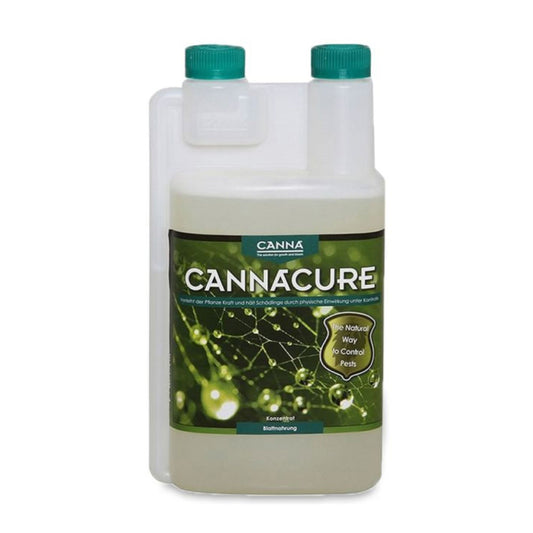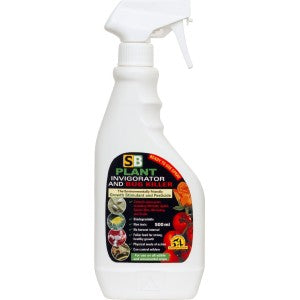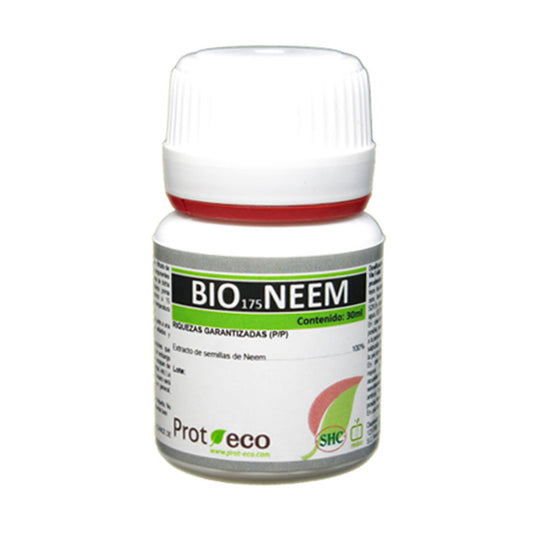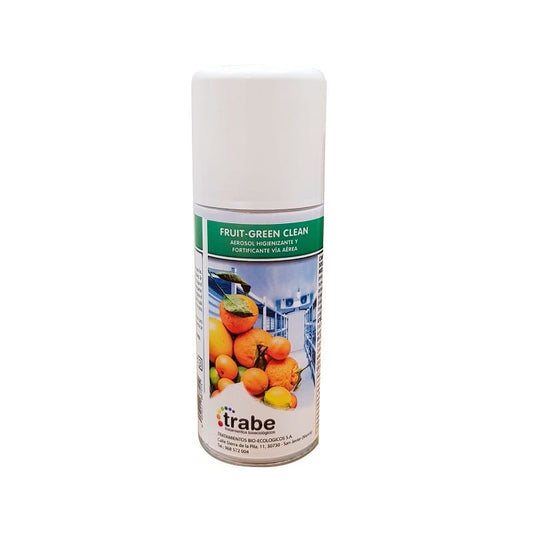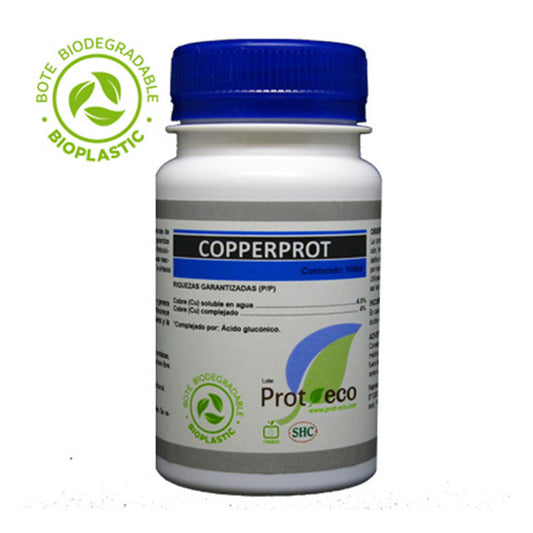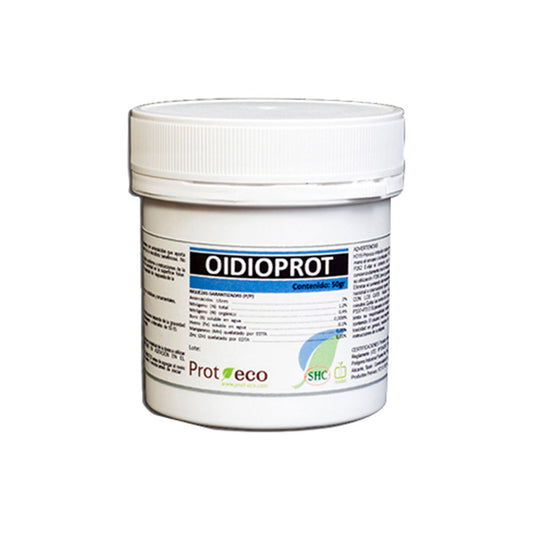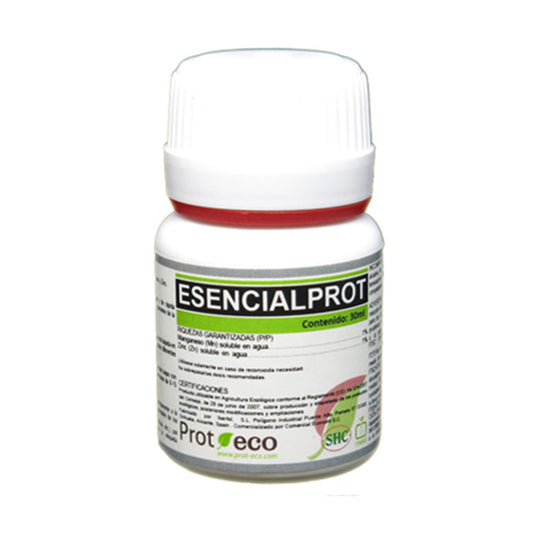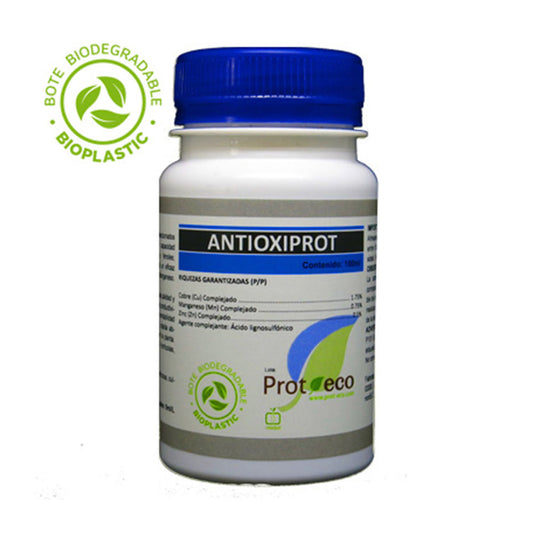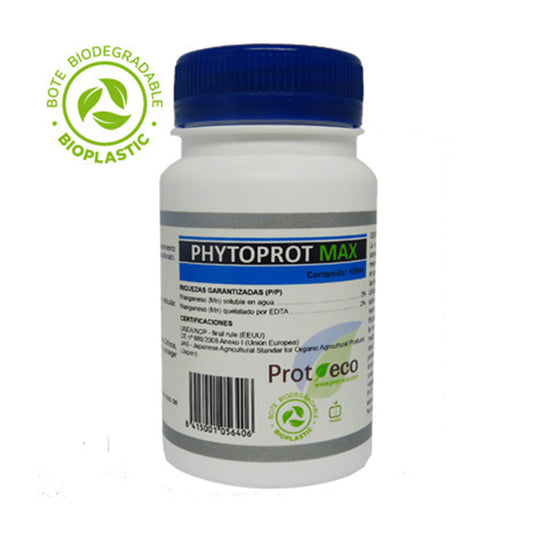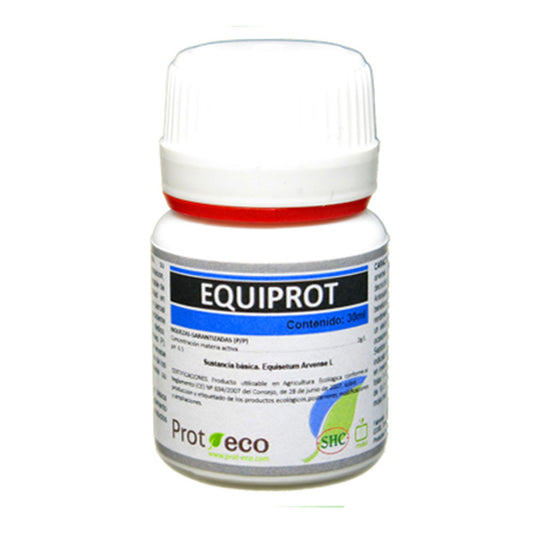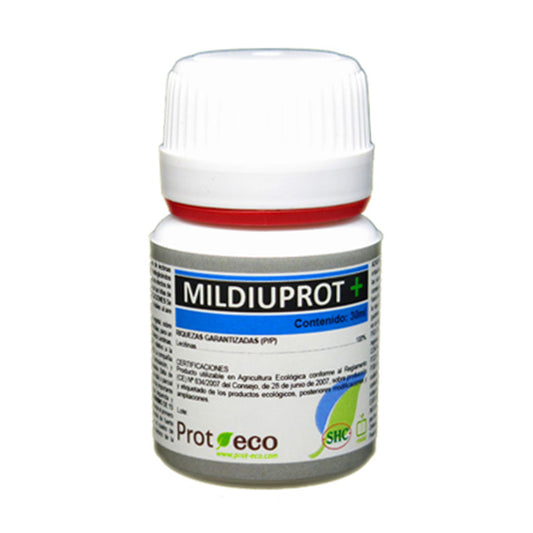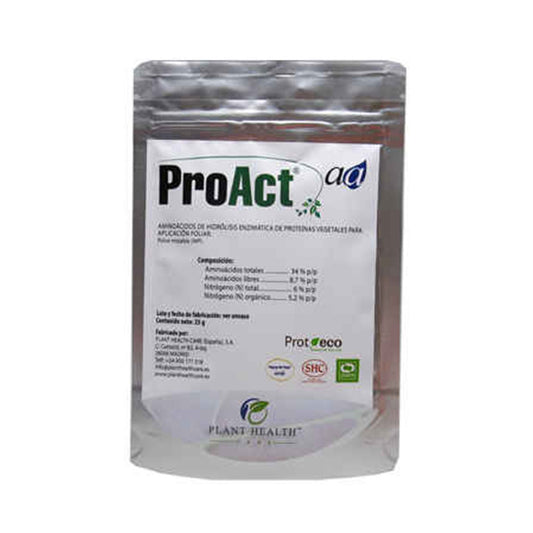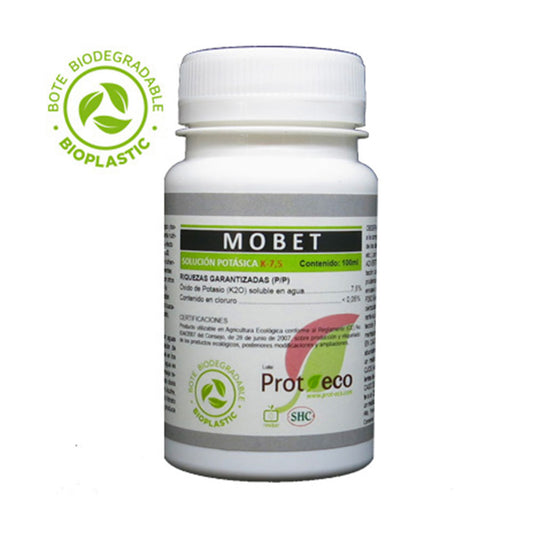What are the most common plant diseases?
In our latitudes and considering the plants we are looking at, we can talk mainly about three
Powdery Mildew
A fungal disease that manifests as a white, powdery coating on leaves and stems. It often develops in high humidity, insufficient air circulation and moderate temperatures, especially in plants planted too densely.
Preparations for treatment and prevention:
Oidioprot from Prot-eco:
A combination of nutrients and growth factors derived from microorganisms that inhibit the development of fungi. This non-toxic product leaves no residue and can be used together withEquiprotfor a stronger effect against fungal diseases. In combination withCinnaprotbecomes one of the most effective remedies against blight.
Instructions for use: Spray every 10-15 days with a solution of 5 ml/l water at pH around 7.5-8.
Cinnaprot: A product created from natural extracts that has a strong regenerating and antioxidant effect. It is effective against powdery mildew and other fungal infections while protecting plants from mites. Suitable for use in organic farming.
Instructions for use: Mix 2-2.5 ml/l of water with pH 6.5-7 and spray liberally every 10-15 days. You can alternate with other products if needed.
Mildiuprot from Prot-eco: Natural antioxidant effective against various types of moulds. It stimulates the defense mechanisms of plants and strengthens their immune system.
Instructions for use: Mix 3 ml/l of water and spray the plants paying attention to the underside of the leaves and stems. Repeat the procedure after 8-10 days.
This product can be used alone or in combination with other productsProt-eco. For more information, read the label or consult us.
Canna Cure by Canna:
A product that offers protection against a wide range of pests and moulds, while nourishing the plant and improving yields. When sprayed, it creates a protective, sticky layer that aids photosynthesis and increases plant vitality. Ecological and safe product.
Instructions for use: Dilute 330 ml in 1 l of water and spray at least once a week. This product cannot be mixed with other preparations, but provides protection against a wide range of problems.
Fungal infections - Fusarium and Botrytis
Fusarium and gray mold are serious fungal diseases capable of destroying entire crops. These infections, caused by a variety of fungal species, can affect different parts of the plant, including stems, roots, and the overall structure of the plant. The main factors contributing to the development of these diseases are high humidity, poor air circulation and improper soil drainage.
Fusarium species
Fusarium at the stem (Stem Canker)
Fusarium wilt often causes stems and branches to swell and crack, and affected parts may wilt and decay. The disease can also affect seedlings, causing them to rot.
Fusarium at the roots (Root Rot)
Fusarium root rot causes the plant to wilt, similar to the effect of water shortage. Stem lesions are often seen, and stem color may change.
Fusarium wilt (Fusarium Wilt)
This form of fusarium is characterized by wilting that does not improve with watering. Although the leaves and stems appear healthy, the plant appears to be poorly watered. Dark or brown coloring of the vascular tissues in the stem is often observed, which in an advanced stage can lead to rotting of the roots and deterioration of the overall condition of the plant.
Fusarium - Identification and Symptoms:
•Early signs: Look for changes in plant color. Fusarium often causes brown discoloration of vascular tissues, especially at the base of the stem.
•Cancer formations: Darkened and sunken lesions appear on the stem, and as the disease progresses, they may cover the entire stem and cause the plant to wilt.
•Foliar symptoms: Leaves above the infected part of the stem may wilt, turn yellow and necrose, even though the plant is well watered.
•Stunting of growth: Infected plants often show stunted growth due to impaired ability to transport water and nutrients.
•Seedling rot: Fusarium can cause seedling rot in the soil zone, especially in overwatered or poorly drained soils.
Fusarium - Prevention and treatment
Prevention is key when dealing with fungal infections, as once they occur they are difficult to eradicate, resulting in reduced yields. To prevent these diseases, observe the following practices and use natural preparations:
•Ventilation and air flow: Ensure good air circulation around the plants, especially in indoor plantings. Fans can help avoid problems related to insufficient airflow.
•Humidity control: Gray mold thrives in moist environments, so keeping relative humidity below 60% indoors is essential. Avoid watering on cloudy or humid days for outdoor plantings.
•Drainage: Make sure the soil has good drainage to prevent water retention, which can favor the development of fusarium.
•Soil sterilization: In indoor plantings, use sterilized soil to reduce the risk of pathogenic fungi.
•Plant hygiene and health: Regularly clean your tools and keep the area around the plants clean.
Healthy plants are more resistant to fungal infections. Products likeCanna Cure,Bio Neem,Messenger ProActa 25andDiamond Shieldcan improve the overall health of the plant and reduce the risk of infection. For best results, use preventively specialized products before the onset of symptoms.
Equiprotstrengthens the structural wall of the plant and protects it from high humidity. Three hours after application, the plant is already protected against rain and dew, which reduces stress and increases yields.
•Instructions for use: Mix 7-10 ml/l of water and spray every 15 days. You can combine with other products according to the situation. Avoid spraying 10-12 days before harvest.
MILDIUPROT +contains antioxidants and is effective against all forms of blight by strengthening the plant's defense system. It is suitable for outdoor, indoor and greenhouse plantings. Spring spraying is recommended.
•Instructions for use: Mix 2.5-3 ml/l of water and spray the whole plant, including the underside of the leaves. Repeat 2-3 times in 8-10 days.
Copperprotis a copper deficiency corrector with harmful effects on fungi and bacteria, being effective against Alternaria, Monilia, Repillo and rust.
•Instructions for use: Mix 2-3ml/l of water and spray every 10-15 days. In case of serious attacks, repeat the therapy with 2.5 ml/l every 3-4 days. Spray liberally, including the back of the leaves, during low light hours and avoid high temperatures. Safe for bees and mycorrhizae.
Botryprotis a specialized product containing nutrients and growth factors that prevent fungal growth and decay while nourishing the plant. Can be combined with other Prot-eco products, for example withEquiprotto better fight advanced fungal infections.
•Instructions for use: Mix 2-2.5 ml/l of water and spray every 10-15 days. Do not spray during the last 15 days before harvest.
Gray mold
It is a widespread fungal pathogen that affects a variety of plant species in both natural and controlled environments. This pathogen is particularly known for its ability to infect soft fruits, vegetables and ornamentals under specific environmental conditions.
Symptoms of Botrytis infection include the appearance of gray-brown mold on the affected parts of the plant. The mold can cover the leaves, stems, flowers and fruits. Infected fruits often become soft and begin to rot, and blossoms may show brown spots and premature wilting.
This pathogen can survive on plant debris and in the soil, as well as in the form of sclerotia (hardened mass of mycelium). In humid conditions, it produces a large amount of airborne spores that spread and infect other plants. It prefers a humid environment, low air circulation and moderate temperatures (15°C - 20°C).
All the preventive measures we mentioned earlier apply here as well. Make sure you have good drainage and free air movement, use sterilized substrates and maintain good hygiene around the plants.
In addition, you can use the following preparations to protect against diseases:
•SB Plant Invigoratorby Growth Technology is an environmentally friendly product that is non-toxic and does not require a quarantine period. It is an excellent choice for regular prevention against moulds, aphids, aphids, whiteflies, mites and other pests. In addition, the product supplies additional nutrients to the plant.
•Instructions for use: If using the spray, spray the plants liberally from all sides. The concentrate is diluted 10 ml per 1 liter of water. Do not spray while the lights are on or in strong sunlight (this applies to all plant preparations!). Do not mix with other preparations. Preventatively spray weekly, and if a problem, spray daily while controlling pests.
•Botryprotis a specialized product containing nutrients and growth factors derived from extracts. It prevents the development of fungi and rot, while at the same time nourishing the plant. It is suitable for all types of cultivation and can be combined with other Prot-eco products, for example withEquiprotfor a more effective fight against advanced fungal infections.
•Instructions for use: Mix 2-2.5 ml/l of water and spray every 10-15 days. Do not spray during the last 15 days before harvest.
•MILDIUPROT +is based on antioxidants and works against all forms of mildew as a phytofortifier. Strengthens the plant's defense systems. It is suitable for outdoor plantings, greenhouses and indoor plants. Spraying is recommended in early spring.
•Instructions for use: Mix 2.5-3 ml/l of water and spray liberally all over the plant, including the underside of the leaves. Repeat 2-3 times in 8-10 days.
 Sold out
Sold out
